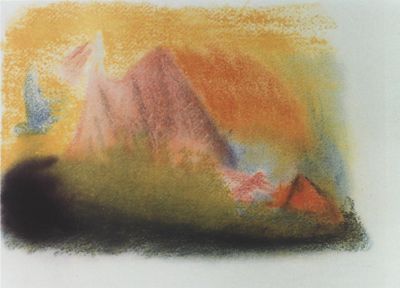Greco-Latin culture: Difference between revisions
No edit summary |
No edit summary |
||
| Line 1: | Line 1: | ||
[[File:Steiner Greece and the Oedipus Motif.jpg|thumb|400px|[[Rudolf Steiner]]: ''Greece and the Oedipus Motif'', pastel 1914]] | [[File:Steiner Greece and the Oedipus Motif.jpg|thumb|400px|[[Rudolf Steiner]]: ''Greece and the Oedipus Motif'', pastel 1914]] | ||
The '''Greco-Latin culture''' or '''Greco-Roman culture''' (747 BC - 1413 AD), the '''Age of Aries''', was the '''fourth post-Atlantean [[cultural epoch]]''', during which primarily the [[intellectual or mind soul]] was educated, especially in a guiding manner, by the '''Greeks''' and '''Romans'''. It is divided into the [[w:classical antiquity|classical antiquity]] (roughly from [[Wikipedia:8th century BC]] to about [[Wikipedia:600 AD]]) and the [[w:Middle Ages|Middle Ages]] (approximately until the [[Wikipedia:15th century|15th century]]). The [[w:vernal equinox|vernal equinox]] was then located in the constellation of [[w:Aries (constellation)|Aries]], so it is also called the '''Aries Age'''. As the most important event, the earthly life of the [[Christ]] and the [[Mystery of Golgotha]], falls into the time of the '''intellectual soul culture'''. | The '''Greco-Latin culture''' or '''Greco-Roman culture''' (747 BC - 1413 AD), the '''Age of Aries''', was the '''fourth post-Atlantean [[cultural epoch]]''', during which primarily the [[intellectual or mind soul]] was educated, especially in a guiding manner, by the '''Greeks''' and '''Romans'''. It is divided into the [[w:classical antiquity|classical antiquity]] (roughly from [[Wikipedia:8th century BC|8th century BC]] to about [[Wikipedia:600 AD|600 AD]]) and the [[w:Middle Ages|Middle Ages]] (approximately until the [[Wikipedia:15th century|15th century]]). The [[w:vernal equinox|vernal equinox]] was then located in the constellation of [[w:Aries (constellation)|Aries]], so it is also called the '''Aries Age'''. As the most important event, the earthly life of the [[Christ]] and the [[Mystery of Golgotha]], falls into the time of the '''intellectual soul culture'''. | ||
In the [[Apocalypse of St. John]], the Epistle to the church of [[Thyatira]] refers to the Greco-Roman period. | In the [[Apocalypse of St. John]], the Epistle to the church of [[Thyatira]] refers to the Greco-Roman period. | ||
Latest revision as of 16:14, 15 March 2021

The Greco-Latin culture or Greco-Roman culture (747 BC - 1413 AD), the Age of Aries, was the fourth post-Atlantean cultural epoch, during which primarily the intellectual or mind soul was educated, especially in a guiding manner, by the Greeks and Romans. It is divided into the classical antiquity (roughly from 8th century BC to about 600 AD) and the Middle Ages (approximately until the 15th century). The vernal equinox was then located in the constellation of Aries, so it is also called the Aries Age. As the most important event, the earthly life of the Christ and the Mystery of Golgotha, falls into the time of the intellectual soul culture.
In the Apocalypse of St. John, the Epistle to the church of Thyatira refers to the Greco-Roman period.
